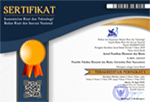The Relationship of Economic Growth, Export Value and Inflation with The Autoregressive Distributed Lag (ArDL) Approach
DOI:
https://doi.org/10.33633/jpeb.v8i1.5299Abstract
Economic growth is one of the benchmarks for the success of a country in running the economy along with the factors that influence it, so this is important to observe. Many previous studies have proven the influence of export value and inflation on economic growth. This study chooses the Autoregressive Distributed Lag (ARDL) model approach to see the dynamics of long-term and short-term relationships for the variables of export value, inflation and economic growth. The research period is quarterly, starting from 2011:Q1 – 2019:Q4 with the type of time series data. The results of this study, through the ARDL model, the variables of export value and inflation are proven to have long-term cointegration or move together in the long term towards economic growth. This study also succeeded in revealing that the variables of export value and inflation have a short-term relationship with a relatively fast adjustment time, which is 2-3 months to return to balance. Keywords:ArDL, export value, economics growthReferences
Adrian D Lubis. 2010. Analisis Faktor Yang Mempengaruhi Kinerja
Ekspor Indonesia. Jakarta: Penelitian pada Pusat Penelitian dan Pengembangan Perdagangan Luar Negeri.
Asfia Murni. 2013. Ekonomika Makro.. PT Refika Aditama: Bandung
Dornbusch, Rudiger & Fischer. (2004). Macroeconomics (9th ed). Mc Graw – Hill Companies. New York.
Friedman, M. (1963). Inflation: Causes and consequences. Asia Publishing House.
Gerrard, WJ and LG Godfrey. 1998. Diagnostic Checks for Single?equation Error?correction and Autoregressive Distributed Lag Models. The Manchester School Vol 66 No. 2: 222-237
Ginting, A. M. (2017). Analisis pengaruh ekspor terhadap pertumbuhan ekonomi Indonesia. Buletin Ilmiah Litbang Perdagangan, 11(1), 1-20.
Gujarati, D., & Porter, D. (2003). Multicollinearity: What happens if the regressors are correlated. Basic econometrics, 363.
Jung, W. S., & Marshall, P. J. (1985). Exports, growth and causality in developing countries. Journal of development economics, 18(1), 1-12.
Kuncoro, M. (2004). Regional Autonomy & Development. Erlangga.
Lapian Marviony, Tri Oldy Rotinsulu, Patrick C. Wauran. 2018. Analysis of Factors Affecting the Export Value Balance in Indonesia. Journal of Scientific Efficiency Volume 18 No. 02.
Lihan I. 2003. Analysis of Export Development and Its Effect on Indonesia's Economic Growth. Scientific Journal of Economics and Business 8 (1).
Mankiw, N. G. (2006). The macroeconomist as scientist and engineer. Journal of Economic Perspectives, 20(4), 29-46.
Nachrowi, N. D., & Usman, H. (2007). Prediksi IHSG dengan model GARCH dan model ARIMA. Jurnal Ekonomi dan Pembangunan Indonesia, 7(2), 199-217.
Pesaran, H. H., & Shin, Y. (1998). Generalized impulse response analysis in linear multivariate models. Economics letters, 58(1), 17-29.
Pesaran, M. H. (1997). The role of economic theory in modelling the long run. The economic journal, 107(440), 178-191.
Pesaran, MH, Shin, Y. and Smith, RJ 2001. Bounds Testing Approaches To The Analysis Of Level Relationships. Journal of Applied Econometrics. 16(3): 289-326.
Widarjono, Agus. 2009. Econometrics: Introduction and Application. Yogyakarta: FE UII econisia publisher.
www.bi.go.id
www.bps.go.id
Zaretta, B., & Yovita, L. (2019). Harga saham, nilai tukar mata uang dan tingkat suku bunga acuan dalam model Autoregressive Distributed Lag (ARDL). Jurnal Penelitan Ekonomi dan Bisnis, 4(1), 9-22
Downloads
Published
How to Cite
Issue
Section
License
The copyright of the received article shall be assigned to the journal as the publisher of the journal. The intended copyright includes the right to publish the article in various forms (including reprints). The journal maintains the publishing rights to the published articles.
This work is licensed under a Creative Commons Attribution 4.0 International License.


.png)









